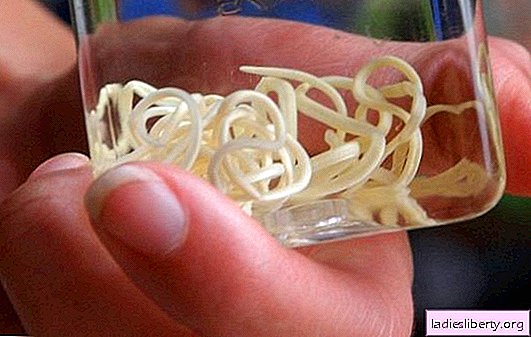
Constipation is a common problem in children. Symptomatically, it manifests itself in a condition in which a child has less than three bowel movements a week. There is an accumulation of feces in the intestine. There is hard, dry and difficult to remove stool. There is bloating and rumbling of the abdomen, painful or unpleasant sensations in the area of the intestine and small pelvis.
Signals of constipation in a child may be
• in newborns, hard stools are less common than 1 time per day, although this may be a normal condition, especially if the infant eats breast milk;
• in children under 4 years of age, hard, hard bowel movements with lower abdominal pain;
• in children older than 4 years, irregular, difficult bowel movements with difficult excretion of feces;
• in children of any age, bouts of pain and bloating with relief after a bowel movement;
• blood on hard bowel movements, underwear.
Constipation usually occurs when the muscles at the end of the large intestine contract and prevent the free passage of fecal masses. The longer the feces remain in the child’s body, the drier and firmer it becomes. Hard stool is poorly removed from the body, provokes painful bowel movements, so the child can consciously hold it and thereby aggravate the problem.
Addiction to constipation is often a family problem. It can begin in early childhood and remain for life. Stool delays most often occur between the ages of 2 and 4, at a time when children begin to independently control their needs and learn to use the toilet. Kids older than 4 years often delay intestinal emptying because they are not used to using an unfamiliar toilet. It also leads to constipation.
In rare cases, when the child systematically keeps fecal masses, the rectum lengthens. The child may stop feeling the urge to have a bowel movement until the rectum is filled to a critical state. In this case, bowel emptying is possible only with the help of an enema, laxatives, or other treatment that the gastroenterologist prescribes.
Constipation in a child under one year old
In infants up to one year, there are two types of constipation: idiopathic and occurring on the background of any disease.
• Idiopathic constipation is a common and common occurrence. The word "idiopathic" means an unknown etiology. With this type of constipation, pathology can occur against the background of various factors of unknown origin. The condition can provoke:
- Short bouts of constipation, lasting up to a day. Malaise is eliminated quickly enough by changing the diet, without any medical treatment.
- Long-term constipation, lasting from a day to 3 days. If the problem becomes permanent, it can cause chronic idiopathic constipation that requires specific treatment chosen by the doctor.
Constipation due to a disease or disorder. This is a rare occurrence in babies. Constipation is a secondary pathology and may occur in the background:
- Some neurological conditions.
- Hypothyroidism - a decrease in the level of thyroid hormones.
- Cystic fibrosis, accompanied by lesions of the endocrine glands, severe disorders of the respiratory and gastrointestinal system.
- Rare diseases with intestinal abnormalities, such as Hirschsprung disease.
- Side effects of any drugs.
But again - all this happens very rarely. Treatment of constipation in a child in infancy mainly comes down to eliminating nutritional problems (regimen and diet).
When constipation in a child is dangerous
If, against the background of constipation, there are alarming symptoms and signs:
• vomiting;
• weight loss or inability to gain weight;
• bloated, painful tummy;
• severe pain in the pelvis and intestines;
• no stool for 48 hours;
• anomalies in the anus (strong compression);
• neurological problems (weak or paralyzed legs);
• sores and ulcers in the anus;
• excessive thirst;
• profuse dark or painful urination with bad-smelling urine;
• nonspecific stool color (pale, white) -
That child is unwell and requires urgent assistance from a qualified doctor - first a pediatrician, and then, if necessary, another specialized specialist.
Constipation in a child from 1 to 3 years
In children aged from one year to 3 years, constipation occurs in about 5%. In most cases, the symptoms of the pathology are not painful and do not act as signs of serious medical illness. The most common cause of constipation is functional and idiopathic abnormalities that occur without signs of injury and infection.
Constipation can occur against changes in diet, insufficient fluid intake, during toilet training, or avoidance of bowel movements due to inconvenience.
When identifying problems should pay attention to the diet of the child. Find out: what a child eats, drinks and how many exercises it gets during the day.
Steps to eliminate constipation in a child
1. Introduction to the diet of a large amount of fiber. Fiber helps the formation of soft, well-transported fecal masses. It is found in many vegetables, fruits and cereals. Fiber must be introduced into the diet of the child gradually to allow the body to get used to unfamiliar food.
When changing the diet should reduce the consumption of fat, food with sugar content, products that do not contain fiber, such as ice cream, cheese, meat, buns, instant foods, ready-made mashed potatoes, children's breakfasts.
2. Drinking a large amount of liquids - fruit and vegetable juices, clear soups. The liquid allows you to keep the stools soft and easy to move in the intestines. Avoid liquids containing caffeine (often found in soft carbonated drinks), which tend to drain the baby's digestive system. As well as drinks containing sorbitol. Sorbitol causes excessive gas and bloating.
Juices such as plum, pumpkin, carrot and apple can naturally quickly eliminate constipation. However, too sweet juices can cause unwanted gastrointestinal problems. When purchasing juices, give preference to low-sugar foods.
3. Exercises. Regular exercise allows the digestive system to remain active and healthy. In this case, daily moderate exercise, cycling - are very useful for the prevention of constipation.
At the age of 1-3 years, it is very important to allocate enough time for the child to perform a bowel movement. It is important not to ignore the urge, as waiting can trigger constipation.
In rare cases where standard measures do not work, treatment with laxatives may be prescribed. The choice of laxative is based on the child's age, the severity of constipation, the body's response to therapeutic measures.
Laxatives for children are usually offered in the form of dragees or dry powders from which tasty drinks are prepared. All laxatives are divided into two types:
• osmotic - created on the basis of polyethylene glycols (keep bowel movements soft based on adsorbed water);
• stimulating - forcing the intestines to contract and remove fecal masses.
What does Dr. Komarovsky say about constipation in children?
Komarovsky’s beloved doctor of modern moms and babies calls constipation a delicate problem that requires attention and real help at an early age.
According to the doctor, various factors can provoke constipation at an early age:
• transfer of the infant from breast milk to milk formulas;
• changing the formulation of artificial nutrition;
• insufficient amount of breast milk, causing starvation;
• the composition of the artificial mixture contains components that contribute to the formation of dense fecal masses;
• due to a common cold or an infectious disease, the temporary absence of intestinal muscle tone;
• insufficient drinking;
• cow protein allergy.
To detect the problem of constipation should pay special attention to the color of feces, its smell and texture. According to Dr. Komarovsky, the color of the feces of a healthy baby breastfed should have a light color, smell like that used by mom and have a liquid consistency that is easily absorbed into diapers. Children in artificial formulas can have feces of any color, texture and smell.
The only reason to be alarmed is Hirschsprung disease. Pathology is characterized by undeveloped nerve endings in any part of the intestine. The disease leads to the accumulation of fecal masses in the child’s body and in most cases requires urgent operational measures in the condition of a qualified hospital.
In other cases, according to the doctor, it is not necessary to sound the alarm when constipation occurs. It should be offered to the child quality food, a sufficient amount of fluids, not to interfere with the physical activity of the child.
If constipation is frequent, but does not affect the general condition of the child, its physiological, physical, and psychological development, the doctor recommends that parents discuss the possibility of using glycerin suppositories and lactulose syrup with the child’s observing doctor.
Syrup is the number one drug for the treatment of constipation in children from the first months of life and up to 4 years. It increases the volume of fecal masses, and artificially causes the urge to defecate. This drug is absolutely safe for the child. It stimulates intestinal reproduction of beneficial bifidobacteria. Today, many dairy products contain lactulose bacteria (duphalac).
To cope with constipation without medication, Dr. Komarovsky advises:
• enter into the diet of the child fresh fruits, vegetables, berries, bran, cereal porridge, diet bread;
• offer the child a slightly undercooked porridge, not very thermally processed, with a high content of liquid;
• Allow your child to drink as much fresh, non-carbonated water as possible, natural juices, compotes, and herbal teas;
• create a child the conditions for active exercise in the fresh air.











